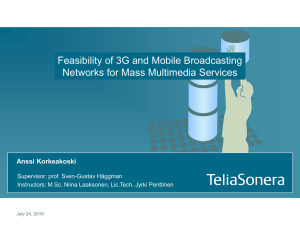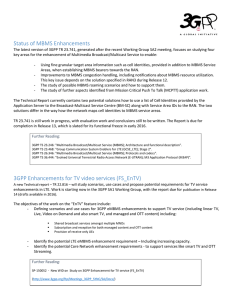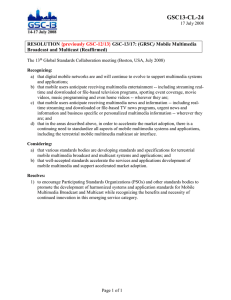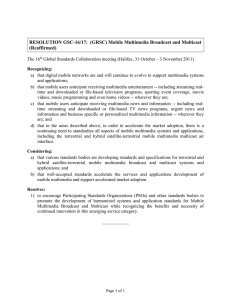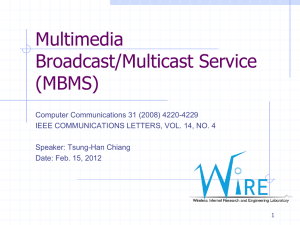Multimedia Broadcast / Multicast Service Henri Virta Thesis Work Presentation
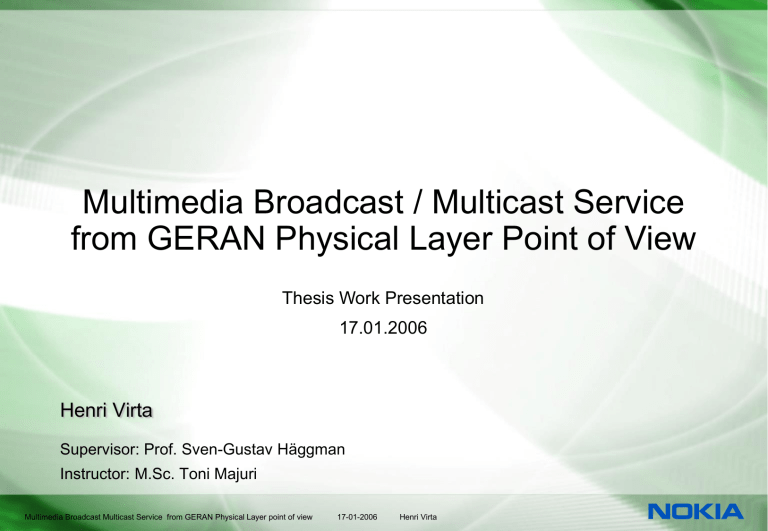
Multimedia Broadcast / Multicast Service from GERAN Physical Layer Point of View
Thesis Work Presentation
17.01.2006
Henri Virta
Supervisor: Prof. Sven-Gustav Häggman
Instructor: M.Sc. Toni Majuri
Multimedia Broadcast Multicast Service from GERAN Physical Layer point of view 17-01-2006 Henri Virta
Contents
• Background
• Objectives & Methodology
• Introduction to MBMS
• Competing technologies
• MBMS from PH Reselection point of view
• Summary and conclusions
Multimedia Broadcast Multicast Service from GERAN Physical Layer point of view 17-01-2006 Henri Virta
Background information
• Multimedia Broadcast Multicast Service (MBMS) is a new feature specified in 3GPP Release-6
• Method of delivering the same multimedia contents to several recipients in the service area
• Main idea behind the MBMS development is to provide multimedia contents simultaneously to several users, while preserving the network and radio resources
P- t- P MBMS
Node B Node B
Multimedia Broadcast Multicast Service from GERAN Physical Layer point of view 17-01-2006 Henri Virta
Objectives & Methodology
• Objectives
Introduce the MBMS service
Compare the MBMS service to other available solutions
Analyze the MBMS service from GERAN/Physical Layer and specifically from PH reselection point of view
• Methodology
Literary study based on 3GPP and ETSI specifications and change requests
MBMS related conference papers and research articles
Discussions within the Nokia organization on MBMS related issues
Multimedia Broadcast Multicast Service from GERAN Physical Layer point of view 17-01-2006 Henri Virta
Introduction to MBMS (1/2)
• The main idea behind broadcast/multicast services is the possibility to save resources in the radio and core networks, by sharing the transmission path
• All MBMS services can be provided with cellular point-to-point (P-t-P) connections, but MBMS is more efficient if the same contents is delivered to several recipients in the same area
• The MBMS service is a solution for transmitting light video and audio clips, although it can also be used for real time streaming videos as well
Multimedia Broadcast Multicast Service from GERAN Physical Layer point of view 17-01-2006 Henri Virta
Introduction to MBMS (2/2)
• MBMS bearer service offers two modes:
• Broadcast Mode :
•
• All users in the broadcast area can receive the broadcast service
Multicast Mode:
• Only users who have subscribed to the specific multicast service and have joined the multicast group can receive the multicast service
• The subscribers can receive services, such as streaming video in a more economical manner.
• The Operator will control the MBMS service and content and can also control the
QoS for the MBMS services
• For the Operator, MBMS will allow more efficient delivery and flexible pricing of existing point-to-point multimedia services
Multimedia Broadcast Multicast Service from GERAN Physical Layer point of view 17-01-2006 Henri Virta
MBMS Procedures
S e r v i i c e a n n o u n c e m e n t
M B M S B r o a d c a s t m o d e b e a r e r s e t t u p
N o t i i f i i c a t t i i o n
D a t t a t t r a n s f f e r
M B M S B r o a d c a s t m o d e b e a r e r r e l e a s e
In the service area
S u b s c r i i p t t i o n
S e r v i i c e a n n o u n c e m e n t t
J o i i n i i n g
M B M S M u l l t t i i c a s t t m o d e b e a r e r s e t u p
N o t t i i f f i c a t t i o n
D a t a t t r a n s f f e r
M B M S M u l l t t i i c a s t m o d e b e a r e r r e l l e a s e
L e a v i i n g
In the service area
Broadcast mode Multicast mode
Multimedia Broadcast Multicast Service from GERAN Physical Layer point of view 17-01-2006 Henri Virta
MBMS architecture
• MBMS architecture is designed so that the existing network elements could be re-used as efficiently as possible.
• A new component: Broadcast/Multicast Service Center (BM-SC) is needed in Core Network
• BM-SC serves as an entry point to content providers and is responsible for enabling the MBMS services to be provided to the end users via the Core and GERAN / UTRAN networks.
GERAN
HLR
Content Provider
Packet Data Network
(e.g. Internet)
BSC
Iu/Gb
Content Provider
UTRAN
Iu
SGSN
GGSN
TPF
BM-SC
RNC
Multimedia Broadcast Multicast Service from GERAN Physical Layer point of view 17-01-2006 Henri Virta
MBMS User Services
• The underlying MBMS technology is transparent to the end-user
• MBMS is planned for Low-to-Medium bit rate multimedia services in areas where several users are receiving the same service
• 3GPP specifies three different service types:
• Streaming : includes time synchronization
•
•
File download : high reliability is required
Carousel : a combination of streaming and file download. Typical carousel service uses still images and text that are updated periodically.
Multimedia Broadcast Multicast Service from GERAN Physical Layer point of view 17-01-2006 Henri Virta
Other available solutions
• DVB-H (Digital Video Broadcast – Handheld)
• High bit rate multimedia services
• Efficient wide-area delivery
• No uplink access and other arrangements are needed
• 3G Point-to-Point Connections
• Low-to-high bit rate multimedia services
•
• Efficient only when delivering content to a few individual recipients in a geographical area
Uplink easily accessible
• CBS (Cell Broadcast Service)
• Kind of a pioneer in mobile broadcast services
•
• Low bit rate messaging (SMS service)
Uplink easily accessible
Multimedia Broadcast Multicast Service from GERAN Physical Layer point of view 17-01-2006 Henri Virta
Comparison to 3G P-t-P connection
• MBMS advantage over traditional P-t-P connections is clear when there are several recipients of the same multimedia data
• Resources can be spared in the Core Network as well as in the Radio
Interface
• The advantage of the MBMS bearer service is greatest if several users are receiving the same service at the same time
3
SGSN
SGSN
GGSN
Core
Network
2
SGSN
SGSN
GGSN
Core
Network
1
P-t-P
Connection
Multimedia Broadcast Multicast Service from GERAN Physical Layer point of view 17-01-2006 Henri Virta
MBMS
Comparison to DVB-H
• DVB-H provides digital television to mobile handsets
• DVB-H is a solution to provide DVB-T(errestrial) programs to mobile users.
The programs are sent to the mobiles in bursts by using IP data casting.
Time slicing technique is used to achieve better battery saving percentage
MPE-FEC error correction mechanism for additional robustness and mobility
• More efficient for delivering high bit rate multimedia services to wide areas, however uplink access not available
• MBMS has a possibility to limit transmissions only to areas populated by recipients
• DVB-H pilot programs already in use
Multimedia Broadcast Multicast Service from GERAN Physical Layer point of view 17-01-2006 Henri Virta
MBMS Service Positioning
• Bearers competing with MBMS:
• 3G Point-to-Point bearers
• DVB-H multicasting
• MBMS vs. 3G Point-to-Point competition in sharing-type services
• MBMS vs. DVB-H competition in publishing-type services
Service Coverage area
3G
P-t-P
Boundary
Area
DVB-H
Multicast
3G MBMS
• What is the overall feasibility of the MBMS service?
• What are the boundaries between competing bearers?
Sharing
(one-to-some)
Publishing
(one-to-many)
User density
Multimedia Broadcast Multicast Service from GERAN Physical Layer point of view 17-01-2006 Henri Virta
MBMS from Reselection point of view (1/2)
• MBMS NEIGHBOURING CELL INFORMATION
• During MBMS the network may send MNCI messages, containing information about the neighbouring cells that are providing the same
MBMS session.
• Delayed Reselection During MBMS
• If the mobile has not received the correct MNCI, the reselection is delayed for 1 second or until the correct MNCI is received
• Neighbour cell measurements
• If feedback is in use the mobile needs to report 6 strongest neighbour cells to the network in MBMS Ack/Nack message
Multimedia Broadcast Multicast Service from GERAN Physical Layer point of view 17-01-2006 Henri Virta
MBMS from Reselection point of view (2/2)
• Reselection without the neighbour cell information
• The MS must first camp to the new cells control channels
• The MBMS service can be requested again from the new cell
• Fast reception resumption
• The MS moves directly to the new cells traffic channel (PDTCH) and continues
• to receive the MBMS session there.
While receiving the MBMS session, the camping procedure is completed in the new cell by receiving the required (P)SI messages.
•
SI2n
• A new system information message introduced in 3GPP Rel-6
• Contains the necessary reselection parameters for the neighbour cells
• MBMS data transfer does not need to be interrupted for neighbour cell (P)SI reception
Multimedia Broadcast Multicast Service from GERAN Physical Layer point of view 17-01-2006 Henri Virta
MBMS delayed reselection scheme
• A simplified flow chart of the delayed reselection scheme
SERVING CELL
MS is camped on a suitable cell receiving an
MBMS session
PDTCH
Reselection is triggered
Suitable neighbour cell found
MBMS
NEIGHBOURING
CELL
INFORMATION received
Yes
No
MBMS
Reselection delay timer started
NEW CELL
MBMS reception continues in the new cells traffic channel
PDTCH
MBMS
Reselection delay timer timeout
No
MBMS
NEIGHBOURING
CELL
INFORMATION received
Yes
NEW CELL
Campping to the control channel
(P)CCCH / (P)BCCH
MS request the
MBMS service from the new cell
Multimedia Broadcast Multicast Service from GERAN Physical Layer point of view 17-01-2006 Henri Virta
Summary and Conclusions
• MBMS is a new bearer service that provides an efficient way of transmitting multimedia information to several users simultaneously
• MBMS is most efficient when several users are receiving the same service at the same time in a localized area
• MBMS will be competing with 3G P-t-P and DVB-H connections
• From reselection point of view, a big challenge will be the Fast reception resumption feature, since it changes the reselection and camping procedure
• Future Work:
• Further studies and analysis of the MBMS features, before starting any design or implementation for MBMS
Multimedia Broadcast Multicast Service from GERAN Physical Layer point of view 17-01-2006 Henri Virta
Thank you!
Multimedia Broadcast Multicast Service from GERAN Physical Layer point of view 17-01-2006 Henri Virta
Additional information
• 3GPP Specifications on MBMS:
• TS 22.146 Multimedia Broadcast/Multicast Service (MBMS)
•
•
•
• TS 22.246 Multimedia Broadcast/Multicast Service (MBMS) user services
TS 23.246 MBMS Architecture and functional description
TS 26.346 MBMS Protocols and codecs
TS 43.246 Multimedia Broadcast Multicast Service (MBMS) in the GERAN
• Other useful 3GPP Specification
• 3GPP TS 45.008, Radio Access Network; Radio subsystem link control
•
(Release 6)
3GPP TS 44.060 General Packet Radio Service (GPRS); Mobile Station (MS) –
Base Station System (BSS) interface, Radio Link Control/Medium Access
Control (RLC/MAC) protocol (Release 6)
• This material is available from the 3GPP homepage: www.3gpp.org
Multimedia Broadcast Multicast Service from GERAN Physical Layer point of view 17-01-2006 Henri Virta
Backup information
• The MBMS service is analyzed from the Physical Layer (PH) point of view presented on the right hand side of the figure below
ETSI protocol stack
Applications
X.25 IP
SNDCP
LLC
RLC
MAC
PH
Data Plane
PDP_IF
SNDCP
LLC
RLC
Physical layer
Control Plane
SM
GMM
MAC
PH
RM
MM
RR
DSP
Multimedia Broadcast Multicast Service from GERAN Physical Layer point of view 17-01-2006 Henri Virta
